Green Supermarket – The impacts of climate crisis on the global world of food retail: Green building, food waste, the reduction of plastic waste, making information accessible to the consumer and more.

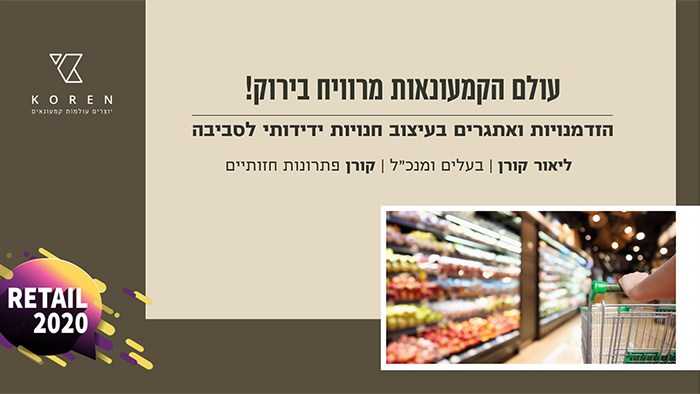
For more than 20 years, we have been establishing retail complexes and accompanying the retail world that is dealing with changes and various interests which surface from time to time. We are attempting to adapt sales sites to the challenges at hand. For example, the online revolution of the past ten years which has dramatically impacted the retail world, the health revolution, as part of which more and more categories of organic health foods are created, the social protest which impacted prices, store design of stores which do not wish to be perceived as prestigious, and more. We attempt to leverage each such challenge into a business opportunity, and to prevent it from leading the chain of stores to foreclose under the impact of these changes, as some of the retailers have experienced over the years.
At the moment we are facing a new and much more significant challenge, as we are talking about a climate crisis and the environmental impact on retail. This article will focus on supermarkets and food retailers, although these issues are relevant to retail in general. Food retail is in the eye of the storm, since it has a significant environmental impact on retail in the aspects of exploiting resources, energy consumption, pollution, emission of greenhouse gasses and over consumption. Supermarkets are the most wasteful retailers in terms of energy consumption of air conditioning, lighting and especially refrigeration, the emission of HFC gasses from air conditioning systems, the size of the store, transportation and deliveries, and the materials used for interior design. The food and grocery traffic passing through the store have severe environmental pollution consequences and greenhouse gasses emissions in the aspects of creating packaging waste (mainly the use of plastic), food waste, selecting the customer’s grocery package, etc.

Israel is backwards compared to many other countries abroad in which the issue is promoted much more intensively, although awareness is on the rise and regulation has begun, along with consumer pressure it is now starting to present itself here as well. In the field of disposable utensils for example, local initiatives of mayors who set regulations to ban its use, together with the cleaning and removal of it from beaches, parents of children in kindergarten apply much pressure to stop the use of it in these facilities, as well as the “letter of the Rabbis” which calls to reduce the use of disposables.
The Green Building Standard is currently being voluntarily adopted in Israel, and the “Forum 15” member cities have undertaken to gradually implement it. Its application as a binding standard will completely change the manner in which supermarkets and food stores are being built, which materials are being used, how they are constructed and disassembled and more. (Late note: On March 3rd, 2020 it was resolved to apply it as a compulsory standard starting 2021).
The field of ESG funds – is gaining a great deal of momentum overseas and has begun to advance in Israel as well. These funds examine the feasibility of investing in companies among other things by adopting the criteria of corporate liability and environment, which constitute an additional incentive to meet environmental targets.

Globally, all the great players are already included. All the big brand names and chain stores are taking part in addressing different aspects of sustainability and environmental quality – beginning with managing the supply chain, energy savings, switching to renewable energy, less packages and decreased use of plastic, reducing food waste, green building, assessing product footprint and more. For example:
Tesco – Reducing food and packaging waste. Since 2018 it is not discarding food worthy of consumption. By the end of 2019, all private label packages are being produced from recyclable or reusable materials, using wind energy in stores, switching to deliveries made by using fuel or biodiesel, and assessing the issue of product footprint. (Link)
Carrefour – In 2018, the company presented an innovative award winning store which is 100% energy efficient in respect of lighting, refrigeration and air conditioning systems, saves 40% in energy consumption and has 60% less carbon emissions. It operates as a start-up for the experimentation and implementation of green packaging in its stores. (Link)
Walmart – Streamlined the chain of supply, removed suppliers that have manufacturing methods which involve a great deal of emissions, and are currently in the process of transitioning to 100% renewable energies as well as improving on the use of fuels. (Link)
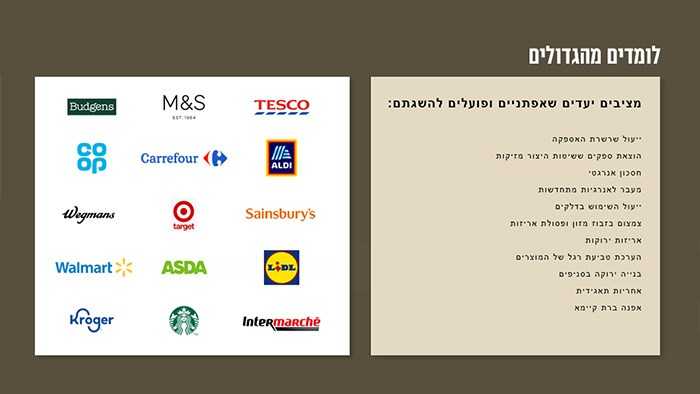
So, where do we begin? Initially from the location and size of the store. In recent years we have been accompanying the blessed process of bringing large stores located outside the cities, into the city centers, in a smaller format of stores. A smaller store obviously uses less energy, it is less polluting, and requires less travelling outside the city. In order for a small store to function better, be profitable and be able to offer good prices to its customers, it must contain nearly all of the categories that a large store is able to provide. We succeed in reducing close to 40% of the store’s space, meaning, by a few hundred meters, resulting in a store which provides a worthy alternative to consumers, even when compared to the larger stores. These stores contain a butchers’ shop, delicatessen, vegetable department and all other categories that can be found in larger stores. These stores even contribute to the prevention of food waste – studies show that those who shop outside the city once a week, buying for the whole week, do not use all their groceries, and much of it is thrown away. For the retailer – a smaller store with higher profitability per square meter, is a good deal, both for the consumer as well as for the environment. This is an example of an environmental choice that is not necessarily more expensive or impacts profitability. We are not talking about additional costs for anyone, but it is rather a matter of awareness.
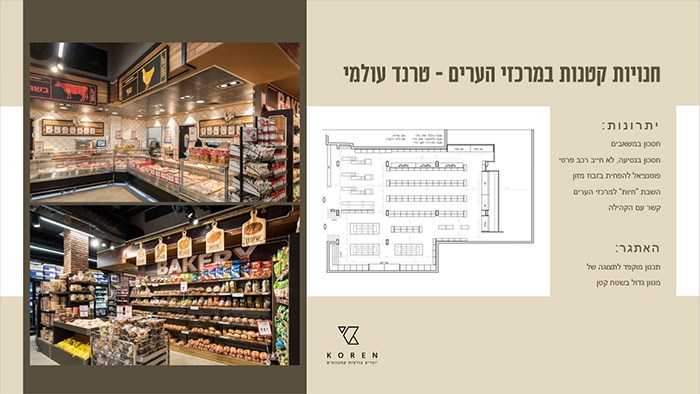
Even in the interior design of the store, we are consistently searching for new materials, technologies and processes, in order to manufacture greener stores. We do not come from the environmentally friendly field, however in recent years, we are making an effort to improve our actions from an environmental point of view.
Attention is paid to selecting quality well-cleaned materials, placing categories within the store according to products’ vulnerability, high durability of displays and facilities in the stores, solutions for interchanging branding, sun-proof cladding for exterior window walls that can be used for advertising and branding, designing energy efficient lighting and more. In this area for example (Pulitzer, vegetable category), we made use of recyclable and environmentally friendly materials only. The design itself aims to a minimal loss of merchandise, for example, how many vegetables should be piled up in the display so not to place pressure on the goods in the bottom, in order that the least amount of food will be thrown away, and so forth.
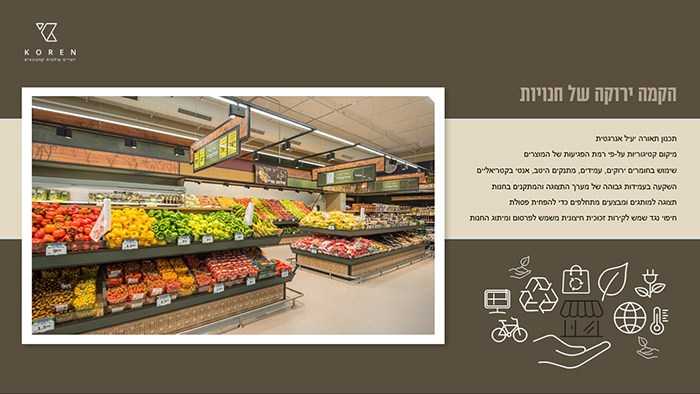
On the issue of sales campaigns, in supermarkets, at any given moment, there are dozens of disposable stands with a life span of about three months, which create a huge amount of waste throughout the year. This year we have executed a multi-use display with the ‘City Market’ chain of stores, that are durable for years and which in fact replaces a great deal of displays throughout its life span.
This display was awarded the “Star of Israel” award. The benefit for the retailer is that the display looks pristine throughout its life span, it does not wear and tear like the simpler displays, it contains much more merchandise, and the branding replacement is carried out by light stickers, magnets or a full skin instead of replacing the whole display each time. Everyone benefits from it, it looks better, and it is primarily important for chain stores which handle their own branding.
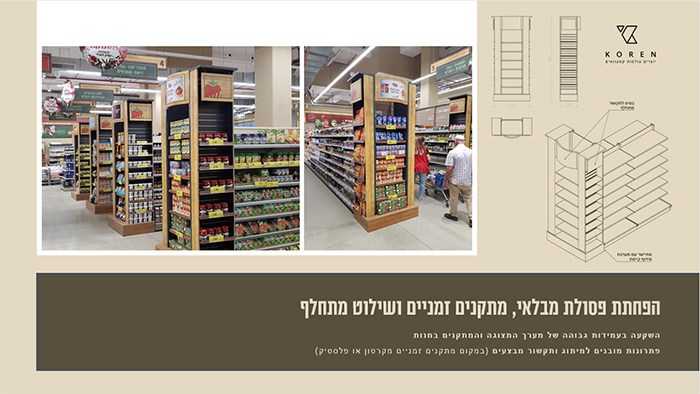
I wish to point out a company of Israeli entrepreneurs which is extremely successful overseas, yet less familiar in Israel, called ‘Infarm’ that developed a local cultivation system for fresh greens produce – lettuces, herbs etc., which to the consumer are considered premium products. Consumers who seek fresh and healthy organic produce and are willing to pay for it, receive very fresh and sterile produce that takes much less space than agricultural space, and it needs not to be transported from anywhere, something which creates value for everyone. At the moment the cost of the product is relatively high, however it projects the face of the future, and the path that things take in terms of technological developments at the points of sale.
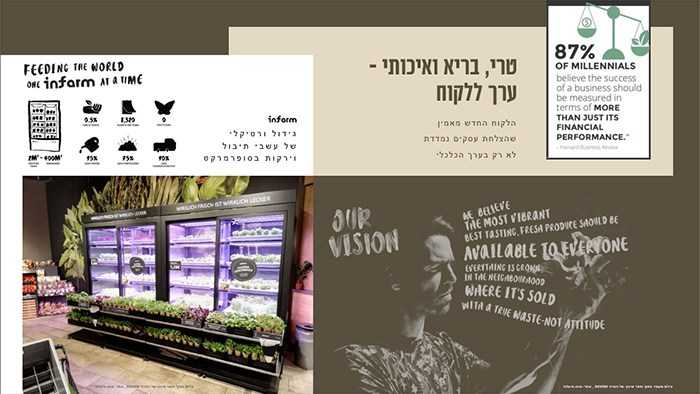
Food and other groceries sold at the supermarket have grave consequences in terms of package waste and plastic damage, and we are all familiar with the damages to our beaches and nature. About 77% of plastic waste originates from food packages and consumer products from the retail and hospitality sectors. We are talking about disposable bottles, food packages, and especially disposable utensils. Only 9% of all the plastic waste in the world is being recycled. The desire is not to increase the recycling volume, but to reduce the use of plastic in packaging as much as possible. Many companies around the world signed the treaty to reduce the use of plastic, with goals for 2025, among them are FMCG and retail companies such as –Nestle’, Coca-Cola, Pepsi, Unilever, Walmart, Target and more. There is much to be done in terms of executing changes on the sales floor which are also able to yield profit, such as selling products in bulk. The areas currently familiar in Israel are spices, vegetables, delicatessens, nuts and seeds and alike. When the site is planned and designed professionally, it usually yields an increase in proceeds of tens and hundreds of percents compared to the off-shelf sales of the same exact products. Another advantage – the retailer can sell the produce in perishable or paper bags, and save on the usual branding on the shelf wars of the branded produce which is often packed several times in surplus packaging of a bag inside a carton. Bulk creates reduced waste and packaging alternative.
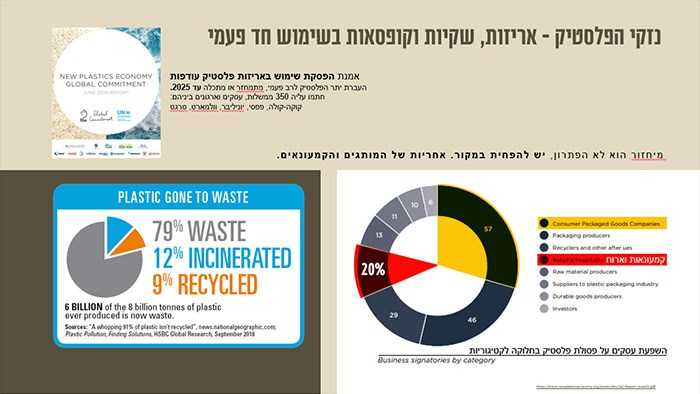
It is important that such a site be planned and designed in an attractive manner compared to a shelf, displaying maximum variety on minimal space, ergonomic, and comfortable to operate, maintain and clean. But why stop with the known categories alone? I have recently visited a ‘Budgens’ chain store. In 60 of the chain’s stores, they challenge the bulk world with other domains, and in fact sell in bulk in the form of refill, milk, mineral water, oils, detergents, as well as offer on the spot grounding of peanut butter and more. (Link) The customer is offered to buy multi-use containers that can be filled over and over again, or they can fill up the containers they bring from home. The ‘Budgens’ chain of stores do not stop with changing the display, but since they have an impact, (60 stores), they succeed in demanding their sub-suppliers to manufacture products void of packaging for them. In 10 weeks the chain had replaced 1800 products previously packed in plastic, with non-harmful alternatives. For example the soaps seen in the images are sold out-of-packet at a reduced price. The products which require packaging are being packaged with biodegradable or paper packaging.
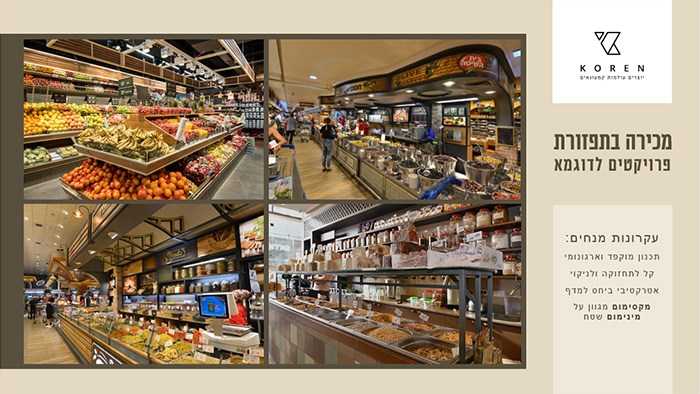
Extending the range of products that can be sold in bulk must be accompanied by making information about the product accessible as an alternative to brand information values. The information should enable the customer to make a healthier or environmentally friendly choice, it contributes to the customer’s experience, can increase shopping duration and encourage him to be exposed to new products while taking into account environmental considerations. The information can include details on the manufacturer, the origins of the product, nutritional values, the environmental footprint and more.
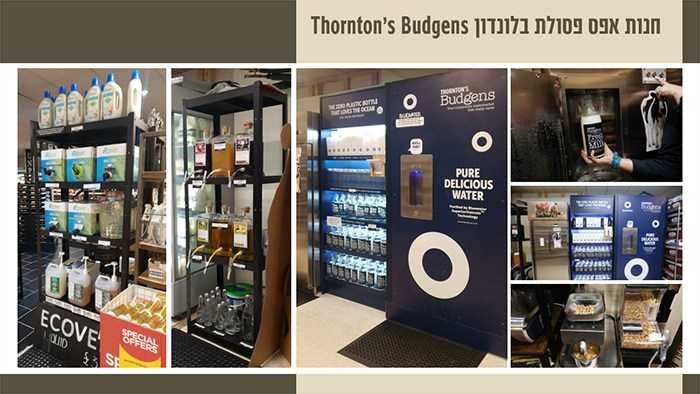
The big suppliers are not excluded, although it may seem that retailers are leading the process. Manufacturers and brands are developing facilities and tools for ‘on the spot’ filling and for selling at refill. Waiving packaging reduces the cost of the product to the customer, and leaves the manufacturer and retailer with a higher profit margin, which leads more and more chain stores to develop sites of this nature. Some are enabling to bring a packaging containers from home in a form of “bring your own container” – in cities around the world, like in Scandinavia for example, in which the quantity of waste generated by a civilian is weighted into his municipality taxes, civilians have an incentive to reduce domestic waste. We all know how much waste we bring home with us each time we visit the supermarket – boxes, bags and alike. The vertical filling of produce contains much more merchandise per square meter, which makes it suitable for small shops as well. Scandinavian chain stores use bulk to market greener – with many more items in the store that the retailer is responsible for, as opposed to branding, it is possible to offer discounts in percentages and not offer 1+1 as it is accustomed, something which may in turn reduce food waste.
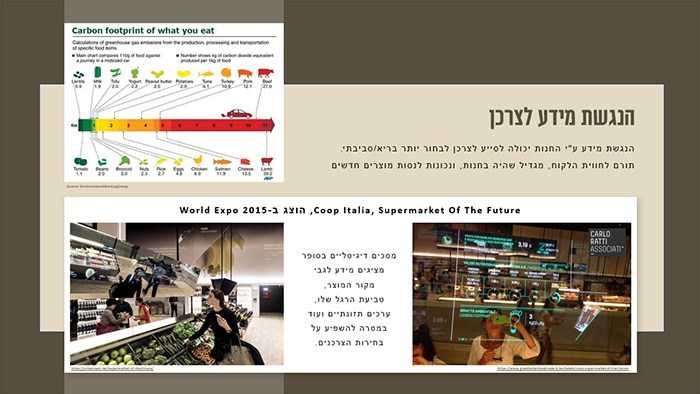
Studies show that 1+1 sales usually bring about over consumption. Selling in a flexible quantity enables to customer to enjoy the discount without selling him more than he truly needs.
Yesterday I have encountered a joint initiative of Asda, Unilever and Kellogg’s for a filling site. (Link) These are developments which happen all the time, and are considered a hot commodity. Everyone is stepping into the issue of filling sites on the premises, at better prices than that of packaged products, and everyone profit from it, including the environment.

The option a customer has to purchase the quantity he needs reduces the waste of food. According to the annual report of the “Leket Israel” Organization, 35% of all the food in Israel is thrown away, out of which 82% in the retailing segment, 50% of which is salvageable. It is possible to turn a profit from it – Two years ago I presented here in a lecture, a pilot conducted by France’s Intermache chain of stores to sell damaged fruit and vegetables. This produce is bought for less, and can be sold at a discount of about 30%, the benefits of which being saving agricultural produce (preventing environmental harm), financial and image gain to the chain of stores, savings for the consumer and making healthy foods accessible to the underprivileged.

In Europe alone, 50 tons of damaged agricultural produce is discarded each year, which is equivalent to the emissions of 400,000 cars. Despite the fact that we are not talking about bad produce but rather about fruit and vegetables which do not meet the store’s standards in respect of size, shape or color, the sale of such produce requires a well designed and planned selling environment. It is important to brand it in a way that it will not be perceived by the customer as being an inferior or failed product. The selling of damaged fruit and vegetables is an expanding trend in many chain stores in Europe, the United States, Australia and the Far East, such as: Tesco, Asda, Morrisons, Aldi, Waitrose, Lidl and more. In Europe it is mainly sold in supermarkets and in the United States the preference is for deliveries. Studies show the willingness of consumers to purchase such produce at a discount even in Israel.

The team at Koren has been trained on the issue of implementing circular thinking in work processes, and we continue to learn something new every day. We are members of the Israeli Green Building Council, are in constant contact with suppliers in the search for raw materials and new technologies, and we invest in expanding our knowledge in order to create more advanced sites. Our goal is to pass on this knowledge to customers and motivate them to implement green thinking in the form of display and sales in the store, and it is not a one day process. The observation is economic. We are seeking the business aspect of the issue, and are convinced that it is a win-win situation for all parties involved with the purpose of generating profit and awareness.
We will be happy to be at your service for the development of green solutions. Turn to us and together we will develop solutions for store design, product mix and sales methods which will steer your business in the right direction as well.
Link to the lecture presentation
